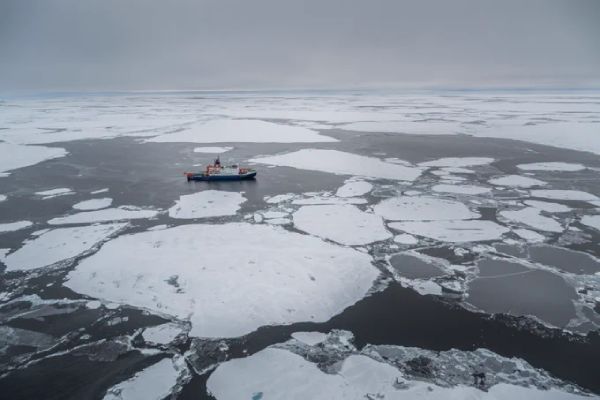If you’ve been following my work, then you know that determining in advance the amount of ice floating on the Arctic Ocean is a difficult task. Research groups and individuals have incorrectly predicted this figure.
Most notably, Harvard Professor of Atmospheric Science James Anderson was quoted in Forbes after delivering a presentation in Chicago on 15 January 2018: “The chance there will be permanent ice in the Arctic after 2022 is essentially zero.” Anderson had previously and famously led the research team that discovered the link between emissions of chlorofluorocarbons and the so-called hole in Antarctic ozone.
If you’ve been following my work, then you also know that the amount of ice floating on the Arctic Ocean is critically important to the continued survival of all life on Earth. The last time there was an ice-free Arctic Ocean was 150,000 to 80,000 years ago. There might have been an ice-free Arctic Ocean after the last Ice Age, 10,000 to 8,000 years ago, although this remains unclear. In any event, millennia have passed since Earth experienced an ice-free Arctic Ocean. This event almost certainly occurred before civilizations arose on Earth. As a result, the aerosol masking effect was not in play. The rate of environmental change resulting from the transition to Earth with and without civilization was not an issue. Both of these phenomena are now critically important. If we transition to an ice-free Arctic Ocean now, we lose aerosol masking. Shortly thereafter, we will lose habitat for humans and therefore for all life on Earth.
Why for all life on Earth? First, there is the very important rate of environmental change in our wake, which will cause the extinction of all life on Earth. Second, there is the uncontrolled meltdown of nuclear facilities. The resulting ionizing radiation will cause the removal of stratospheric ozone, which will super-heat the planet. This outcome was subtly displayed in the 2021 film, Finch. As I have indicated previously in this space, filmmakers apparently know more about atmospheric phenomena than paid climate scientists.
An article from NASA on 31 May 2024 describes the factors that contribute to an ice-free Arctic Ocean. The article is titled NASA Mission Flies Over Arctic to Study Sea Ice Melt Causes. NASA is the acronym for the U.S. National Aeronautics and Space Administration. I’ll read the first paragraph from NASA’s short article: “It’s not just rising air and water temperatures influencing the decades-long decline of Arctic sea ice. Clouds, aerosols, even the bumps and dips on the ice itself can play a role. To explore how these factors interact and impact sea ice melting, NASA is flying two aircraft equipped with scientific instruments over the Arctic Ocean north of Greenland this summer. The first flights of the field campaign, called ARCSIX, successfully began taking measurements on May 28.” ARCSIX is the acronym for Arctic Radiation Cloud Aerosol Surface Interaction Experiment.
The deputy science lead on this effort is quoted in the NASA article: “The ARCSIX mission aims to measure the evolution of the sea ice pack over the course of an entire summer. There are many different factors that influence the sea ice. We’re measuring them to determine which were most important to melting ice this summer.”
This research project is described by another scientist involved in the effort: “An important goal of [the Arctic Radiation Cloud Aerosol Surface Interaction Experiment] is to better understand the surface radiation budget – the energy interacting with the ice and the atmosphere.” In other words, the National Aeronautics and Space Administration within the U.S. government understands the critical importance of retaining the ice floating on the Arctic Ocean. This agency has created a team comprised of researchers who typically work in three different research arenas: the surface of the sea ice, aerosols, and clouds. Aircraft will be flown through and below the clouds to document the surface properties of the ice and also the amount of energy being reflected off the ice. The data collected will include aerosol particles, optical properties of the clouds, chemistry, and profiles of the atmosphere above the ice.
The article ends with a quote from the science lead for this mission: “The area off the northern coast of Greenland can be considered the last bastion of multi-year sea ice, as the Arctic transitions to a seasonally ice-free ocean. By observing here, we will gain insight into cloud-aerosol-sea ice-interaction processes of the ‘old’ and ‘new’ Arctic – all while improving satellite-based remote sensing by comparing what we’re seeing with the airborne and satellite instruments.”
I’m surprised this research program is only now getting started. We have long understood the importance of Arctic sea ice to the continuation of habitat for life on Earth. There will be no life on Earth in the absence of at least 1 million square kilometers floating on the Arctic Ocean. This is important. This is very, very important.
Better late than never? Maybe. Or perhaps this is yet another example of a federal government focused on irrelevant issues for far too long.
Arctic Sea Ice Hits Annual Minimum, Antarctic Sets New Record
Author
"Dr. Guy McPherson is an internationally recognized speaker, award-winning scientist, and the world’s leading authority on abrupt climate change leading to near-term human extinction. He is professor emeritus at the University of Arizona, where he taught and conducted research for twenty years. His published works include 14 books and hundreds of scholarly articles. Dr. McPherson has been featured on TV and radio and in several documentary films. He is a blogger, cultural critic, and co-host of his own radio show “Nature Bats Last.” Dr. McPherson speaks to general audiences across the globe, and to scientists, students, educators, and not-for-profit and business leaders who seek their best available options when confronting Earth’s cataclysmic changes." source






